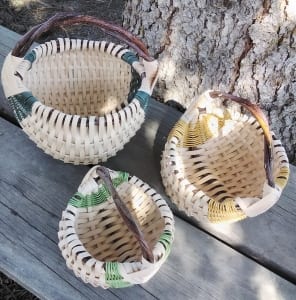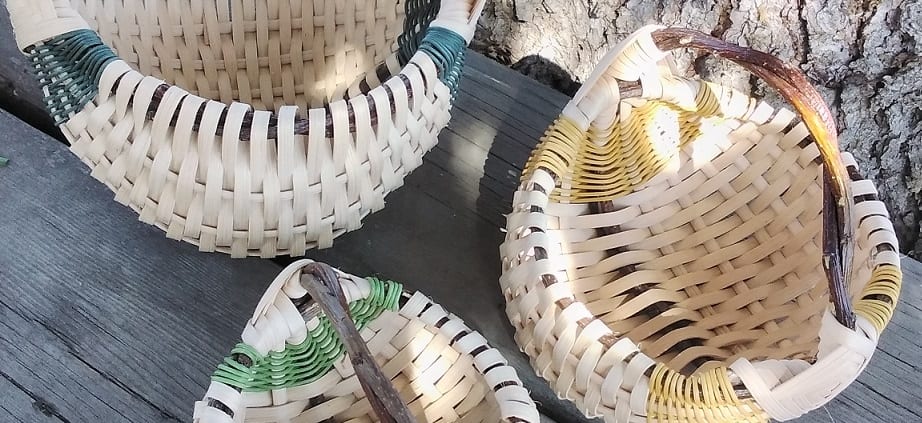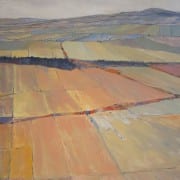Basket Making — Lisa Kostelak Perfects an Ancient Art

Surrounded by grasses and trees, a series of hand-woven baskets by Colville, WA, artist Lisa Kostelak, celebrates the natural world.
Once upon a time, and not that long ago, there was no plastic. For thousands of years of human history, if people wanted to carry something around, from babies to drinking water, they wove a basket. It took, and takes, skill, patience, and an eye for artistry to create a useful basket.
“I have been making baskets for 35 years,” says Lisa Kostelak of Colville, WA.
“I made my first basket in a craft store in a mall in Florida, when I was in just the right place at the right time.
“Though I had been interested in learning for a long time, it was hard to know where to start in the old, pre-Internet days.”

It’s about two-inches high. This little basket is woven from dandelion stems, birch bark, and rattan. By Colville, WA, artisan Lisa Kostelak
Today’s technology worship aside, one of the best ways to learn a craft that employs our hands, hearts, and brain is from an actual person who learned how to do it from another actual person. And it is for this reason that Kostelak, who taught herself painstakingly through books and a tremendous amount of trial and error, passes on what she knows through teaching small, personal classes. Basket Making 101, contrary to what we’ve been told all these years, is not an easy A.
Basket Making 101 Is Not an Easy Class
“I learned to weave using rattan, which is a readily available material from Southeast Asia. It is lovely to work with, and I still use it to make many baskets.
“Over the years I have expanded, using material that I forage locally, including cedar bark, tules or rushes, birch bark, bear grass, red osier, even dandelion stems. I am always on the lookout for stuff to weave with.”

They’re graceful, elegant, yet connected to the earth. The bark-based handles of this trio of baskets adds the perfect finishing touch. By Colville basket weaver Lisa Kostelak.
So it’s not just a matter of unpacking a cardboard box of materials and following a sheet of directions. For Kostelak, basket making involves a solid knowledge of plants and their environment, as well what to harvest, when and how, and what to do with it afterwards to prepare it for weaving. (Show of hands here: who in the room has even heard of “red osier” or “tules,” much less knows how to identify and gather them?)
“I forage anywhere — my backyard, where I’ve planted willow, juncus, red osier, to weave with. I also use my fruit tree pruning, among other garden plants.
“My tules, or rushes, I get from a friend’s pond. We have a nice visit, then cut rushes and load them into my van.”
Sustainable Thinking
For cedar, she gets permission from a private landowner to select a tree that is damaged and will need to be taken down. Once it is cut, she strips off the outer bark, then peels the inner bark or cambium layer, which she coils up and cures for a year before soaking and cutting it into strips for weaving. On hikes through the Colville National Forest, she looks for bear grass, birch bark from dead trees, scouring rush, and whatever else catches her eye.

The basket itself has something to say about its final shape and form. By Lisa Kostelak, artisan weaver from Colville, WA.
“I always ask before harvesting live material,” Kostelak says, because an essential part of making baskets — by real, regular people throughout history — has been working with the environment, not against it. In today’s arena of industrial, profit-driven, multi-billion, even -trillion, dollar corporations, this respect for, and awareness of, sustainability is becoming as lost as the knowledge of making baskets.
“I love working in 3D, with shapes, textures, and colors, making something that is functional and beautiful,” Kostelak says. Her studio, she adds, was formerly known as the family room. With the kids grown and flown, she has commandeered the entire space, with foraged materials stashed everywhere.
“I love spending time there, with the music turned up as loud as it goes, just getting into the rhythm of the weave.”
Baskets Are Timeless Technology
Kostelak sells her work through area shops and regional craft shows, and her wares have found homes from Seattle to San Francisco, from New York to Florida, from Nova Scotia to New Zealand. There is no end to creative inspiration, she says, because the materials themselves are dynamic, redolent of life, tactile, and almost demanding to be touched, handled, interlinked and intertwined.
“I get new ideas while I work. Sometimes I get an idea from the colors or textures of material stored together. Sometimes I dream a basket, and write it down when I wake up.”
The skill, and the baskets, transcend time, and there is a rush (no pun intended) to creating something that artisans have been making for far, far longer than industry has churned out plastic bags and petro-chemical products. There’s a human touch that endures from one age to the next.
This is good to remember the next time we overhear someone scoffing that a class is as easy as Basket Making 101. We can be free to retort,
“Have you ever actually woven a basket? It’s not as easy as you think.”
 Lisa Kostelak is the featured Art Event at Wenaha Gallery from April 20 through May 17, 2021.
Lisa Kostelak is the featured Art Event at Wenaha Gallery from April 20 through May 17, 2021.
Contact the gallery, located at 219 East Main Street, Dayton, WA, by phone at 509.382.2124 or e-mail art@wenaha.com. Gallery hours are 9 a.m. to 5 p.m. from Monday through Friday, and by appointment. Visit the Wenaha Gallery website online at www.wenaha.com.







Leave a Reply
Want to join the discussion?Feel free to contribute!